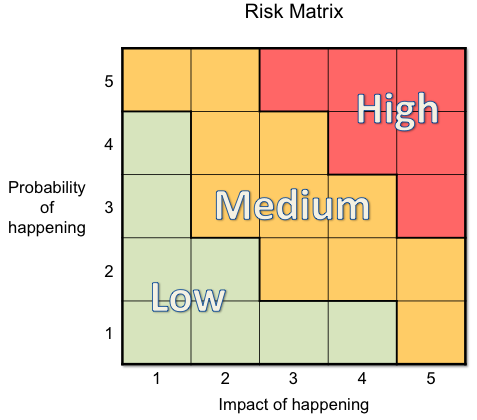What are the largest risks to your small business? Do you have plans in place to reduce those risks?
Risk cannot be eliminated but it can be managed. The following tool is a way to record, prioritise and monitor individual risks so that you can reduce their impact on your business.

Step 1: Identify risks
A risk is an uncertain event that if it happened would negatively affect your business.
Brainstorm across every aspect of your business to identify all significant risks. Consider both internal and external risks.
Step 2: Record on a ‘Risk Register’
Record each risk identified on a ‘Risk Register’.
The ‘Risk Register’ should include the following.
- Risk description
- Impact rating
- Probability rating
- Risk score
- Risk class
- Action to be taken
- Individual responsible
- Date reviewed
Step 3: Rate the Impact
For each risk identified ask, “What would be the impact on my business if this risk actually happened?”. For example, what would be the impact of a fire where you work? How many days would your business be closed for? Would it recover at all?
Rate the impact on your business between 1 and 5, with 1 being low impact through to 5 being high impact. Record on the ‘Risk Register’.
Step 4: Rate the Probability
For each risk ask, “What is the probability or likelihood of this event happening?”. A meteor hitting your business premises might be devastating but how likely is it?
Rate the probability of the event happening between 1 and 5, with 1 being extremely unlikely to happen and 5 being almost certain to happen. Record on the ‘Risk Register’.
Step 5: Calculate the Risk Score
For each risk that you have recorded on the ‘Risk Register’ calculate the ‘Risk Score’ as the Impact rating multiplied by the Probability rating.
Risk Score = Impact Rating x Probability RatingThe ‘Risk Class’ is high risk, medium risk or low risk and can be assigned from the ‘Risk Score’ as follows:
- 1 to 10 is Low risk (L)
- 11 to 14 is Medium risk (M)
- 15 to 25 is High risk (H)
The ‘Risk Score’ and ‘Risk Class’ are shown on the chart above.
Record on the ‘Risk Register’.
Step 6: Determine Action
Now that you hopefully have a complete list of risks that are prioritised by their ‘Risk Score’ you can determine what the necessary action for each should be. Low risk items will usually require little to no action but dealing with high risk items may incur significant costs.
When you decide on what action to take assign responsibility for that action to an individual.
Summary
Risks cannot be completely eliminated but they can be identified and their potential for damaging your business reduced.
By creating a ‘Risk Register’ you can prioritise and monitor those risks and so set your business free.
© Business Set Free Ltd 2013
This is just one of many articles that you can find at BusinessSetFree.com or click to subscribe to our free e-newsletter.






